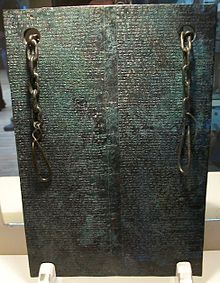
Back Catalogue des Textes Hittites German کتیبههای هیتی Persian Textes hittites French Hettita szövegek katalógusa Hungarian Pustaka bangsa Het ID ხეთური ტექსტები Georgian Hettitische teksten Dutch Literatura hetycka Polish Hetitska besedila Slovenian Hettitisk litteratur Swedish

The corpus of texts written in the Hittite language consists of more than 30,000 tablets or fragments that have been excavated from the royal archives of the capital of the Hittite Kingdom Hattusa, close to the modern Turkish town of Boğazkale or Boğazköy. While Hattusa has yielded the majority of tablets, other sites where they have been found include: Maşat Höyük, Ortaköy, Kuşaklı or Kayalıpınar in Turkey, Alalakh, Ougarit and Emar in Syria, Amarna in Egypt.
The tablets are mostly conserved in the Turkish museums of Ankara, Istanbul, Boğazkale and Çorum (Ortaköy) as well as in international museums such as the Pergamonmuseum in Berlin, the British Museum in London and the Musée du Louvre in Paris.[1]
The corpus is indexed by the Catalogue des Textes Hittites (CTH, since 1971).[2] The catalogue is only a classification of texts; it does not give the texts. One traditionally cites texts by their numbers in CTH. Major sources for studies of selected texts themselves are the books of the StBoT series and the online Textzeugnisse der Hethiter.[3]
- ^ Hoffner & Melchert 2008, 2-3
- ^ Laroche, Emmanuel (1971). Catalogue des textes hittites. Études et commentaires, 75 (in French). Paris.
{{cite book}}: CS1 maint: location missing publisher (link) The first edition came out in 1956. A supplement was published in 1972: Laroche, Emmanuel (1972). "Catalogue des Textes Hittites, premier supplément". Revue hittite et asianique. XXX: 94–133. - ^ "Textzeugnisse der Hethiter (Hethitologie Portal Mainz)" (in German, French, Italian, and English). Gerfrid G.W. Müller & Gernot Wilhelm. 2002–2013. Archived from the original on 2019-06-15. Retrieved 2020-04-22.